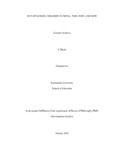
Please use this identifier to cite or link to this item:
https://hdl.handle.net/20.500.14301/100| Title: | OUT OF SCHOOL CHILDREN IN NEPAL: WHO, WHY AND HOW |
| Authors: | Acharya, Laxman |
| Citation: | Acharya, L. (2018). Out of School Children in Nepal: Who, Why and How. [Unpublished thesis], Kathmandu University. |
| Issue Date: | Jan-2018 |
| School: | SOED |
| Department: | DODE |
| Level: | Ph.D. |
| Program: | PhD in Development Education |
| Abstract: | Out of School Children (OOSC) is an alarming issue, not only in Nepal but globally and especially at a time when global agenda like Education for All and Sustainable Development Goals have many challenges to face. In Nepal, the context of ensuring free and compulsory education as a fundamental right under the constitution of Nepal 2015, poses even greater challenges, and especially due to the out of school children. Though, the issue of OOSC is mainly raised from development perspectives as right-based issue in developing countries like Nepal, this research was carried out to understand the complex process of OOS phenomenon and its major dynamics. A pragmatic research paradigm with a sequential mixed methods research was designed to explore the „who‟, „why‟ and „how‟ aspects of out-of-school phenomenon. Both quantitative and qualitative data were analyzed in order to understand the issue in a holistic manner. This study first assessed the prevalence and distribution of out-of-school children in Nepal and also inferred the relationship between out-of-school events with its contributing factors in general. The macro level statistical results were drawn using both descriptive and inferential statistical tools such as correlation, chi square test, and logistic regression models where the National Population and Housing Census (NPHC), 2011 data and Nepal Living Standard Survey (NLSS) data of 2010/11 were the major data sources. Analysis of the quantitative results as the background of the study provided the framework for qualitative enquiry to uncover the complexities of OOS issue. In this context, I selected an ethnic community in Kathmandu purposefully for the ethnographic study. I generated six ethnographic cases of school dropout children to assess the process of out-of-school phenomenon. The quantitative analysis of this research confirmed many of the commonly identified factors of OOS event in earlier research within Nepal and abroad, such as school related, households related, and those that are related to local culture and parents and children related factors still remain valid and significantly contribute to out-of-school event. Similarly, the ethnographic study also revealed that the school dropouts and their parents experienced multiple discomforts and complexities in school, household and community leading them to take their decisions on school dropout. This study then discusses findings on the basis of past studies and developmental/social theories to depict the complexities of the out of school phenomenon. In so doing, I mainly used the human capital/development theory and Bourdieu‟s theory of practice to explain the out-of-school phenomenon. One of the major insights I gained from the ethnographic engagement in the research is about „educational ceiling‟. The educational ceiling is the mental disposition constructed in human mind about minimum level of formal education that they have perceived relevant to their life and livelihood. This ceiling is the composite of many constituents such as peoples‟ life experience, level of exposure, educational expectation and the level of discomfort felt due to various adverse circumstances they face during children‟s schooling. This „educational ceiling‟ of individuals is the guiding forces to prepare decision maker for school dropout. However, at the time of taking decision of school dropout, people account the tension between pain and gain of schooling experienced by them. This study encompasses developmental, theoretical, and methodological implications. The findings of this study are helpful to development practitioners and policy makers to pursue the crux of school dropout phenomenon that why and how a child becomes out-of school. Theoretically, this study showed that school dropout phenomenon is associated with the complexities of peoples‟ thinking and being. At the stage of thinking about school dropout, peoples‟ behavior was guided by their past dispositions while at the time of decision they acted somehow like a rational thinker. It reveals the changing behavior of human being in daily life – thinking mode of existence to being mode of existence. Methodologically, the macro level analysis generalized the causal relationship between out-of-school and its contributing factors for wider population while the micro level study was helpful to explore issues in depth with contextual and individual experience of out-of school phenomenon. Mixing the approaches was fruitful to understand the issue in a holistic manner. |
| URI: | http://101.251.6.110:8080/handle/20.500.14301/100 |
| Appears in Collections: | Research Project |
Files in This Item:
| File | Description | Size | Format | |
|---|---|---|---|---|
| PhD_Laxman_Acharya.pdf | 1.82 MB | Adobe PDF |  View/Open |
Items in DSpace are protected by copyright, with all rights reserved, unless otherwise indicated.